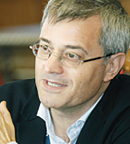The demand for radiotherapy across all European countries will increase by an average of 16% between 2012 and 2025, with the highest expected increase being for prostate cancer cases (24%), according to a new study published by Borras et al in Radiotherapy and Oncology.1
These projections came from a study by the Health Economics in Radiation Oncology project of the European Society for Radiotherapy and Oncology (ESTRO). The results were also presented at the ESTRO 35 Conference, held in Turin, Italy.

Yolande Lievens, MD, PhD
“Because radiotherapy involves significant outlay in equipment costs as well as in staff, long-term planning is necessary in order to achieve the required results. We, therefore, decided to try to forecast the radiotherapy needs of new cancer patients in the short to medium term to gain sufficient time for the purchase of appropriate machinery and the personnel training that will be required to meet this need,” said coauthor Yolande Lievens, MD, PhD, Chair, Radiation Oncology Department, Ghent University Hospital in Belgium, and President-Elect of ESTRO.
Study Details
The research group—made up of senior radiation oncologists and epidemiologists from Belgium, Denmark, Spain, France, and Australia—analyzed European cancer incidence for the year 2013 by country and by tumor site, using data from the International Agency for Research on Cancer GLOBOCAN project on worldwide cancer incidence and mortality.
Using statistical modeling, the researchers applied the 2012 country, sex, and site incidence rates to the population forecast for 2025 in order to obtain projections of new cancer cases for that year.

Josep M. Borras, MD, PhD
“Although these projections take demographic changes into account, we are unable to estimate the potential impact of changes in risk factors,” said coauthor Josep M. Borras, MD, PhD, of the University of Barcelona, Spain.
Key Findings
The detailed estimates for many different tumor sites produced some major increases. There were relative increases of more than 25% in patients with rectal cancer for whom radiotherapy would be indicated in Spain, The Netherlands, and the Czech Republic, whereas Belgium, the United Kingdom, and Denmark had estimated increases of more than 20%.
Prostate cancer showed the highest expected increase over the period, with a 24.4% rise, followed by bladder cancer (21%) and multiple myeloma (20.4%), whereas projected increases in female breast cancer, lymphomas, and head and neck cancer were below average.
About 4 million new cancer patients are expected in Europe in 2025. This estimate is based on demographic changes and represents a 15.9% increase on the 3.4 million diagnosed in 2012, assuming that overall cancer rates remain unchanged. Of these 4 million, the number of patients who would benefit from radiotherapy at least once during the course of their disease would rise from approximately 1.7 million patients in 2012 to 2 million in 2025—an increase of 16.1%.
This increase in new cancer cases is largely because the European population is aging due to increased longevity and lower fertility levels. Indeed, the very old (80 years and over) now make up the fastest-growing population age group in Europe.
Effect on Policy

Cai Grau, DMSc
“Being able to estimate the number of new cancer patients requiring radiotherapy is essential if we are to be able to plan for radiotherapy services,” said coauthor Cai Grau, DMSc, of Aarhus University Hospital, Aarhus, Denmark. “We have shown clearly that the need for radiotherapy across Europe will increase substantially by the year 2025.”
Dr. Lievens said, “We hope that our study will focus the minds of European policymakers on the need to invest in radiotherapy.” ■
Disclosure: For full disclosures of the study authors, visit www.journals.elsevier.com/radiotherapy-and-oncology/.
Reference

